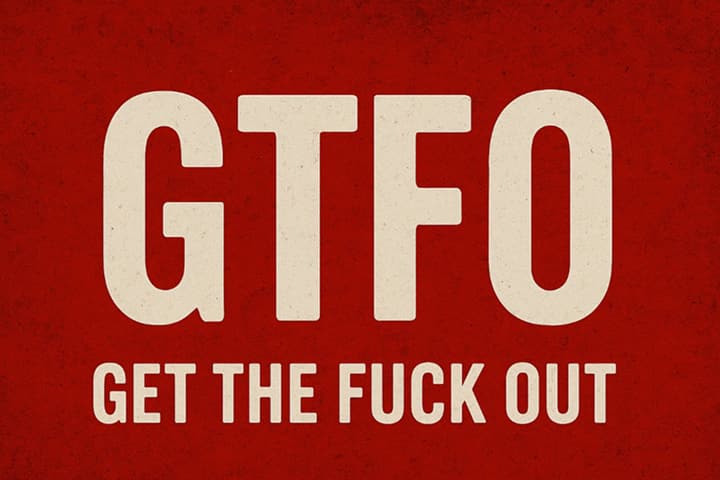Over time, Internet culture has redefined the GTFO meaning from a short-hand acronym to an expanded social term. In both online communities and contemporary verbal communication, these four letters now possess significant meaning which extends far past their direct definition.
This article investigates the history of “GTFO” while analyzing situations where the expression becomes offensive and providing direction for proper use.
What is GTFO meaning?
The acronym GTFO represents the internet slang phrase “Get The Fuck Out.” Online users use GTFO as an abbreviation to convey intense emotional responses, spanning from disbelief and frustration to complete dismissal The use of GTFO normally depends on the circumstance. Typically GTFO functions as an abrupt command for someone to depart instantly or halt their ongoing activities.



However, while the literal meaning of GTFO is aggressive. Individuals often use it in friendly conversations or digital interactions to respond to shocking information.
The expression possesses a natural aggression that people often take advantage of to signal urgency. But its acceptability, however, depends on the communication context.
Ensure minors’ online exposure with the parental control!
The origin and development of GTFO
The modern meaning of GTFO developed from its origins during early internet and gaming era.
The phrase “Get the fuck out” entered digital spaces during the early 1990s with the growth of online forums alongside gaming communities. During heated debates and competitive games, people often used GTFO as a forceful dismissal against annoying disruptive or mistaken actions. The direct and intense nature of this expression matched perfectly with the competitive gaming scenarios. Players shouted, GTFO! through voice chat features or wrote it in-game texts. To tell opponents to leave or to show their disbelief about poor gameplay decisions.
The early 2000s then witnessed GTFO’s transition to online platforms such as Something Awful and 4chan. As its powerful dismissive nature became a popular form of humor on these forums. Users turned the expression into a caption for reaction images by adding “GTFO” to angry pictures of cats. As this usage served to ridicule ridiculous online content. The widespread use of GTFO however faced both positive and negative reactions throughout the years.
While some people interpret it as a cool harmless way to express themselves other users believe it promotes hostile behavior.
How teens use the slang GTFO?
GTFO’s meaning varies from use to use. To the young people of today, GTFO is not meant to be taken literally but rather humorously, sarcastic, and as an outlet to emotions.
Here is how teens have incorporated this slang into their online lives.
Text messages
- Reacting to absurdity. When reacting after you received a friend’s ridiculous take on a current affair or event. For example, “ Do you actually mean that pineapple should be included in the list of pizza toppings? GTFO.”
- Mock outrage. As a lavish reaction to minor inconveniences, such as – “God, my mother doesn’t allow me to go to Starbucks anymore. GTFO with that.”
- Dramatic exits. When light-heartedly concluding a conversation, for example, “He said, this convo is trash. GTFO, see you tomorrow.”
- Comment sections. Short, punchy replies to cringe or outdated posts—”GTFO with this 2012 energy.”
- Viral challenges/TikTok. Appears in skits where someone responds to something absurd (for example, a fake negative opinion followed by a teenagers’ reaction “GTFOOO!”).
- Self-deprecation. Some teens make fun of themselves, for example “Me: forgot my homework: brain: GTFO.”
Memes
- Reaction images. Memes of celebrities or cartoon characters side-eyeing the camera with “GTFO” captions.
- Editable templates. Blank versions of GTFO memes allow teenagers to personalize them in order to create inside jokes.
IRL (In Real Life): Ironic Catchphrase
- Group banter. Said laughingly when friends are being ridiculous, for instance, when a friend says “I actually like math’. GTFO!”
- Parodying authority. Lightheartedly imitating parents/teachers (for example, “mom told me ‘clean my room’. GTFO, I’m hibernating.”).
Teens embrace GTFO as it is a phrase that combines rebellion with humor in the shortest of sentences. Which is the essence of modern-day internet. Though perfectly acceptable when used between members of the same generation, its use in front of adults is still rather jarring.
Is GTFO appropriate for teens?
The meaning of GTFO among teens depends on how the term is deployed and who receives it. A large number of teenagers today employ the GTFO acronym in digital settings. Although they do so without any genuine intent to offend. The acronym GTFO appears commonly within text messages and social media platforms when friends want to joke with each other.
However, the phrase remains unsuitable for formal and professional settings as it contains censored profane language. Also, educators and parents tend to see this expression as disrespectful when it is used aggressively.
Teens who use GTFO in their communication need to recognize how their words might affect others. And should exercise appropriate language sensitivity based on the context.
How does aggressive slang like GTFO impact minors?
The usage of aggressive slang terms like GTFO results in different levels of impact on young people. Depending on the frequency of use and the specific context.
Here are different ways this aggressive slang may influence individuals.
Normalizing hostility
- Desensitization. Excessive exposure to harsh language causes teens to lose their ability to differentiate between jokes and aggression. They start perceiving dismissive acts as acceptable.
- Escalation. The casual use of aggressive language in social media frequently cause serious arguments leading users into heated online conflicts.
Impact on communication style
- Reduced empathy. Young people who repeatedly use dismissive language might experience a diminished abilities to comprehend and relate to emotional experiences of others.
- Impaired emotional expression. While aggressive slang gives people ways of communicating complex emotions such as frustration and discomfort. They provides no healthy method for doing so effectively.
Understanding of social boundaries
- Blurred lines. The constant use of negative speech makes it challenging for young people to tell apart friendly banter from true offensive statements.
- Difficulty adapting to different contexts. Frequent use of strong language in social environments leads to diminished communication ability to adapt to different contexts among teenagers.
Mental health & self-perception
- Internalized negativity. Young individuals who experience frequent dismissive language may start to feel unloved and unworthy despite such statements being intended as jokes.
- Cyberbullying risk. Aggressive speech can become an easily weaponized tool especially when users have the ability to operate without revealing their identities.
Miscommunication & social consequences
- Authority clashes. The use of aggressive slang by teenagers in informal interactions with teachers or parents can trigger disciplinary actions against them.
- Misread tone. Digital communication lacks facial expressions and vocal cues which makes sarcastic comments look like bullying to those who do not understand the tone.
How parents can navigate safe online interaction for minors?
Effective management of online interactions among minors requires for parents to combine multiple methods of proactive intervention.
The following guidelines show parents how to oversee their teenagers’ digital communication activities online.
1. Open and ongoing communication
- Start early. Initiate conversations about internet security, proper online communication as well as web-related perils before your child reaches the social media stage.
- Create a safe space. You should create a safe environment where your teen feels free to discuss negative online events without facing any consequences.
- Encourage critical thinking. Have a conversation about how they would react if someone used the term GTFO to address them. And analyze the consequences of their language choices on others.
2. Establish clear guidelines and expectations
- Define acceptable Use. You need to define specific standards for both appropriate and unacceptable conduct in online platforms. Which will specify verbal expression rules along with sharing restrictions.
- Explain the “why”. Explain the purpose of your rules instead of simply presenting them. Show how offensive words result in negative outcomes by connecting the guidelines to these damaging effects.
- Approved platforms. Together determine the best social media and apps that match their age and maturity standards.
3. Quietly stay in the know using digital tools
Without being invasive, modern digital tools let you keep a pulse on your child’s online world. Some of these tools include parental control apps that serve as essential teen monitoring and management tools. They provide multiple features that aid in achieving online safety —without needing to constantly intervene.
FlashGet Kids stands out as one such parental control application which assists parents to safeguard their children during digital interactions.
FlashGet Kids provides multiple tools and features that help parents track social media language and user interactions. These include.



- Social app detection. Parents use the social media detection option to establish keyword alerts which detect harmful or offensive content.
- Daily usage reports. The app delivers comprehensive reports about your teen’s duration online and their frequent applications to detect abnormal use of their devices.
- Screen mirroring. Screen mirroring enables parents to observe their children’s screens in real time for better visibility into their social interactions.
- Alerts. Your device will alert you right away when your child experiences content containing dangerous language, threats or inappropriate behavior.
The parental control app FlashGet Kids enables parents to establish an equilibrium between teen protection and teenage autonomy.
Final words
The digital evolution of the meaning behind GTFO has led to its transformation from being an insult to having adjustable interpretations based on the situation. This originally aggressive dismissal has evolved to having distinct usage patterns that vary according to the relationship dynamics and social environment.
The goal for parents and educators should be to develop digital literacy education. Which helps students understand when different types of language are appropriate.
FAQs
The acronym GTFO appears frequently in online chats, text messages and social media on platforms such as Twitter, Reddit and TikTok. This slang term has gained popularity within gaming platforms along with teen social circles which frequently utilize slang for expressing shock, humor and annoyance.
Within Snapchat users employ GTFO as an abbreviated form of “Get The Fuck Out” which they use casually with their friends. Users employ GTFO mostly to convey their astonishment or doubting reactions to Snapchat content instead of using it as a literal command to depart.

